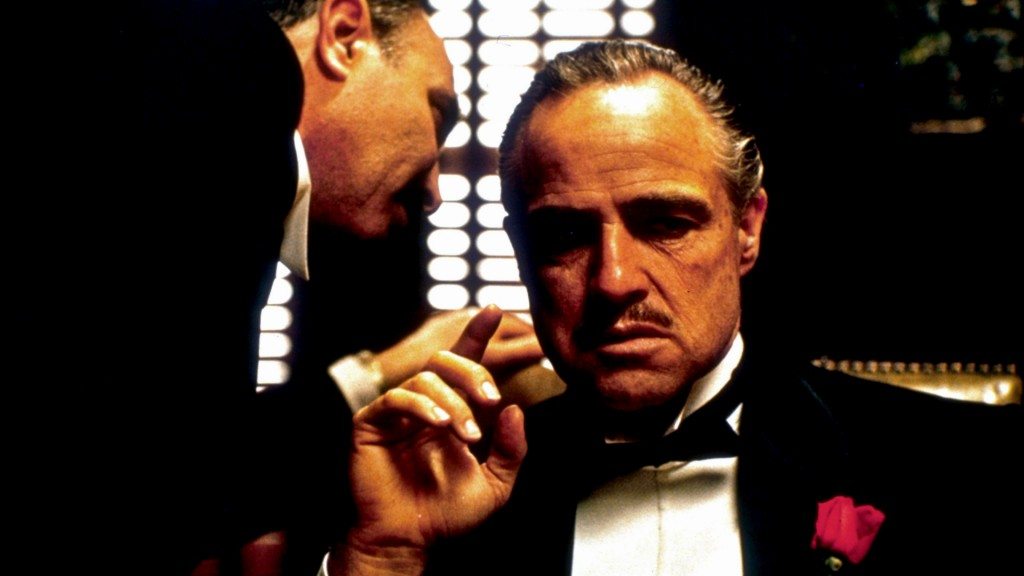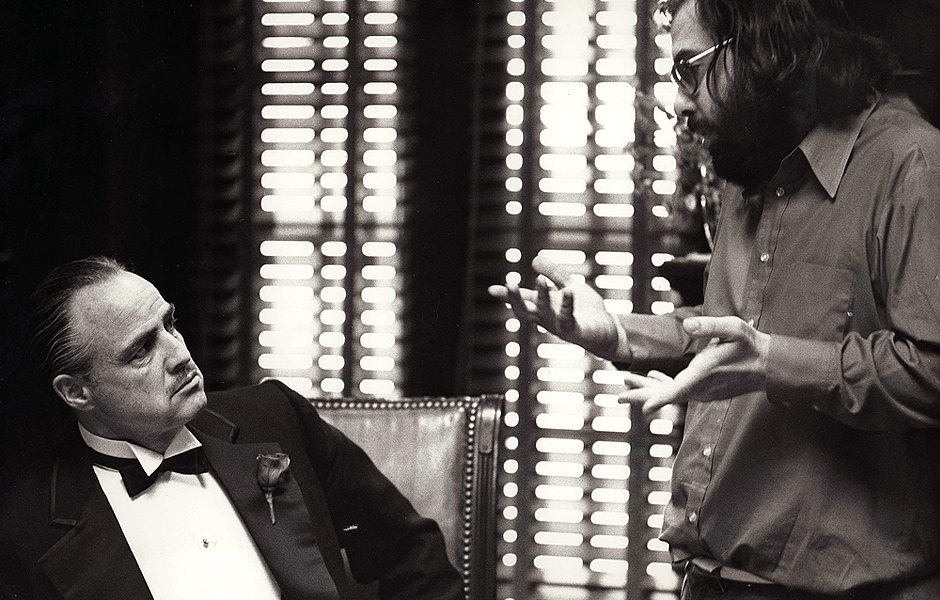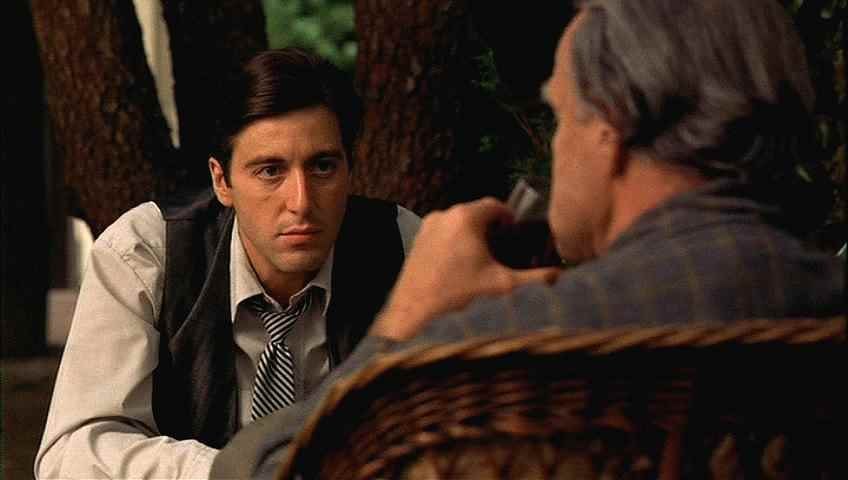“I believe in America”, are the first words we hear in ‘The Godfather’, spoken by a terrified undertaker who has come to ask the godfather, Don Vito Corleone, for a favor, which cannot be refused on his daughter’s wedding day. The American he believes in, that he worked so hard to fit in too, has betrayed him and he comes to the old mafia chieftain for a justice he would never dream of getting in the courts of America. Vito Corleone loves America too, and for the same reasons as the undertaker, though they move in very different circles. This one-act will lock them on a path moving towards one another, a night when the godfather comes to ask for payback for his favor. And of course, that is the night Bonasera, the undertaker, dreads.
More than forty years have passed since the releases of The Godfather (1972) and its sublime sequel The Godfather Part II (1974) which changed the course of filmmaking in North America and were embraced around the globe as the pinnacle of movie making on this continent. Like Citizen Kane (1941) before it, the films are hailed as the finest in American film history, the best in world cinema.
Mario Puzo had written the best seller, The Godfather, and Paramount Pictures had bought the film rights. Producer Robert Evans was assigned the film and hired recent Oscar winner Francis Ford Coppola to co-write the film and direct the picture. Did Evans know what he was getting into? Did he know the thirty-two-year-old Coppola would create one of the most astounding films in film history? Could he have anticipated the clashes with Coppola that became the stuff of legend?
From the very beginning, Coppola made it clear he would not be bullied or pushed around, and he was pretty aware that was why they had hired him, to bully and push him around! He would not have it. Working with Puzo he saw something deeper in the book that neither Evans nor Puzo has counted on, a chance to make a movie about America, about the immigrant experience, about a father and sons, and the perversity of the American Dream. Drawing on his own Italian heritage and relationship with his father and siblings, Coppola went for something very intimate, very deep, very personal, resulting in the most remarkable crime film ever made.
The studio had wanted for the role of Don Vito Corleone, the Godfather of the title, actors such as Burt Lancaster, Ernest Borgnine, Frank Sinatra and Laurence Olivier. Coppola saw one man, Marlon Brando as the seventy-year-old mafia chief, but at that point in his career Brando was all but finished, reviled by the industry and studios, responsible for more than one film going radically over budget and over schedule. No one wanted to work with Brando, but Brando wanted the part and Coppola wanted Brando. The director convinced the actor to do a screen test, though he presented it to Brando as something else, he got the man on tape nonetheless. Brando slicked back his hair, used some makeup to make his eyes look sunken into his head, put cotton in his cheeks to flesh them out and spoke in a raspy voice. No longer was Coppola looking at forty-seven-year-old Marlon Brando, instead, he was looking at a seventy-year-old Italian mafia chief with the look of a bulldog. The studio chiefs saw the test, loved it, and then were told it was Brando.
He was cast on the spot.
More fighting took place over the casting of the sons, with Jack Nicholson, Warren Beatty, and even WASPish Robert Redford being offered roles in the film. Again Coppola fought for the actors he wanted, which included James Cann, Robert Duvall and John Cazale. For the plum role of Michael, the director wanted virtually unknown Al Pacino, but the studio refused, calling him “a midget”. Coppola held strong, and finally, they back down allowing the director to have his cast.
They fought once more, about the setting of the film, which as in the book, Coppola wanted to set it in the years right after the end of the Second World War. To save money the studio wanted it set in 1972, but both Coppola and Puzo stated their case, and as it made sense the studio backed down. There would be many more fights between Coppola and producer Robert Evans, as Evans saw himself an artist which he clearly was not. The actors and crew made clear their devotion to Coppola, and the film, despite Evans interference belonged to Coppola.
Even during filming Coppola was convinced he would be fired any day, and when Oscar winner Elia Kazan showed up on the set, the young director thought it was a matter of days. Little did he know Brando had gone to the producers and made it clear if Coppola was fired, he would walk, lawsuit or not. SO Paramount left him alone to make the film and when it began previewing for the critics, there were not enough words to praise the picture.
Hailed as the greatest American film since Citizen Kane (1941), The Godfather (1972) opened in the spring of the year to the amazing box office and rave reviews across the board. Within days of opening the film was already the stuff of legend, within three months it had passed The Sound of Music (1965) to become the highest grossing film in movie history, but more entered into the consciousness of America. Quotes from the film became part of the American language, the score from the picture sold millions of copies, and at year’s end, the film began winning awards. Five Golden Globes, ten Academy Award nominations, the DGA Award for Best Director and finally, the Academy Award for Best Picture, Best Actor, and Best Screenplay.
Coppola’s storytelling is patient, drawing us into the film by showing us the love the Corleone family has for one another at the wedding of Connie, the intimacy they share with their close friends and extended family. When an attempt is made to assassinate Vito, and slowly Michael realizes the men that shot him are not going to be stopped, he is drawn into the family to help his father, gunning down the men responsible in a restaurant in one of the cinemas most famous scenes. From that moment on, Michael becomes the heir apparent to the seat of the godfather, groomed for taking over the family by his father and adopted brother Tom Hagen. He will prove more ruthless than his father, brilliantly, like a fine chess player, eliminating the heads of the four other families in one fell swoop, on one afternoon; he even has his brother-in-law killed for setting up Sonny years earlier.
Keep your friends close, but your enemies closer.
And Michael does just that.
When his father dies, he knows someone will come after him and that someone will be close to him and a traitor. When it is Tessio, who has been loyal to his father for years, Michael does not hesitate to have the old man killed, knowing it was not personal, just business.
In the final moments of the film, Michael lies to his wife Kay, one of many he has told her and one of many he will continue to tell her. Kay watches through a crack in the door as Clemenza kisses his hand and calls him Don Corleone, and at that moment Kay nows he has lied to her and is the same kind of man as his father, a man he once vowed never to be. He has solidified his power by having killed the heads of the other mafia families in the days before he moves his own family and interests to Las Vegas, where he is the most powerful chieftain in the country.
There are so many great moments in the film, the opening, the wedding in which we are slowly introduced to the family, the shooting of the Don, the famous killing of Paulie (leave the gun, bring the canolli), Michael gunning down Sollozzo and McLuskey in the restaurant, the massacre of Sonny, Tom Hagen telling the Don of Sonny’s death, the Don’s paralyzing speech to the members of the Five Families, the death of the Don in the garden, and Michael solidifying his power by killing the other heads of the major families. Mixed in with these startling set pieces is a remarkable story of a father and his sons, his love for his boys and theirs for him, willing to do murder for him.
The Godfather (1972) was nominated for ten Academy Awards including four for acting. Brando was nominated and won for Best Actor while James Cann and Richard Castellano were up for supporting actor. Incredibly, dominating the film, Pacino was nominated for supporting actor, though he should have been in the Best Actor category. Brando is onscreen for, under thirty minutes, Pacino dominates the movie. To say a star was born is an understatement, he would go on to be one of the finest actors in American cinema, at least in the seventies.
Pacino’s evolution from an idealistic war hero, wanting nothing to do with the family business, turned killer and head of the family is an astounding piece of film acting. It is all in the eyes, and we see him become cold, ruthless, we watch as his very presence radiates a danger even Brando does not have.
Brando is remarkable as Don Vito, a powerful and dangerous man who carries his power easily. There is a telling cut from one of the most famous scenes in the film. Jack Woltz awakens to find a horse head in his bed, a dire warning from the family Corleone, and the next cut we see is of Vito enjoying his morning, blissfully aware that he has sent a harsh message, knowing he will cut the desired result.
The rests of the cast are superb, from James Caan’s hot-headed Sonny, John Cazales’ weak Fredo through to Diane Keaton as Kay, Michael’s tortured wife. It is simply a flawless work, surpassed in American cinema only by its sequel The extraordinary The Godfather Part II (1974). That Coppola could make a film that surpassed the genius of The Godfather (1972) is a testament to his own genius. By creating a film more complex, darker and more powerful than the first he would cement his own reputation as the cinema’s greatest director.
Read More: Best Gangster Movies of All Time




